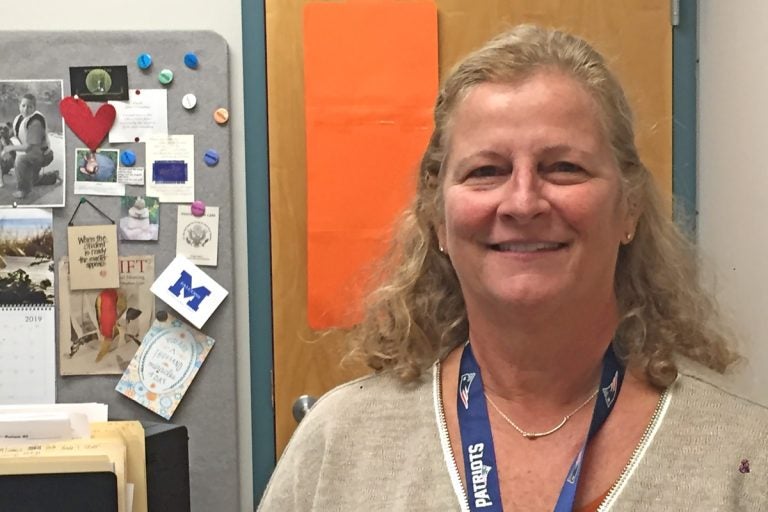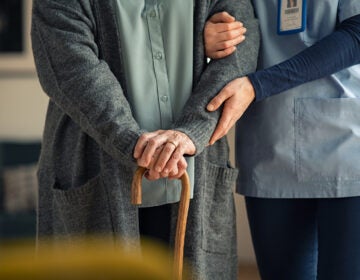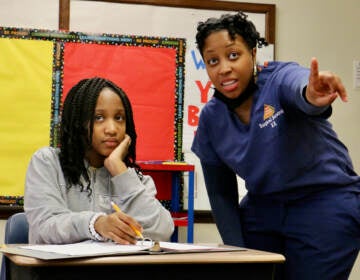Through good times and bad — how school nursing has evolved over time
School nurses now have to add shooter drills and concussion protocols to the day-to-day responsibilities that come with tending to the health needs of students.
Listen 05:32
Joyce O’Connor in her office at Mashpee Middle-High School in Mashpee, Mass. (Kate O’Connell/For WHYY)
Joyce O’Connor entered school nursing over 20 years ago and has a total of 40 years of nursing experience under her belt. She has a distinct perspective on how school nursing has changed over the years because her mother also was a school nurse.
Though the day-to-day responsibilities have remained fairly consistent — documenting mandated health screenings, triaging ill or injured students, performing first-aid, and preparing action plans for medically complex students — many aspects of the role have changed.
“We keep evolving as health changes,” O’Connor said. “We have Narcan in the school, for example.”
Narcan is the drug that reverses opioid overdose. O’Connor’s school is in Mashpee, on Cape Cod in Massachusetts. The region has been especially hard hit by the opioid crisis, and the prevalence of substance abuse disorder in the community is reflected in high school-age children as well. Whether it’s the actual abuse of painkillers by a student or the impact of a family member’s drug use, the crisis has implications for a school nurse.
O’Connor also collaborates with the athletic department to ensure up-to-date concussion management protocols to safeguard athletes, and there has been an increase in providing mental health services to students throughout the school day.
School nurses all around the country do this kind of work, she said. “Those are issues that aren’t unique to the Cape or unique to Mashpee. That’s what we’re all faced with.”
Another concern in schools across the country is the fear of an active shooter incident. To prepare, most U.S. schools conduct drills yearly for students to practice. The drills are known by the acronym ALICE, for alert, lockdown, inform, counter, evacuate.
ALICE drills present “what if” scenarios to students and guide them through some decision-making practices for self-preservation that, it is hoped, will help them in the event of an actual shooting.
Just before school began this year, O’Connor’s school, Mashpee Middle-High School, had a drill that was much larger in scale. Police, firefighters, and emergency medical service personnel were involved in a widespread emergency preparedness drill. Roles were assigned, and fake wounds were applied to the teacher and student participants as the Mashpee police and fire departments practiced coordinating a response to a shooter in the school.
“You were either a victim, or a helper, or a hostage,” O’Connor said of the assigned roles.
The stress of an active shooter incident would be akin to finding yourself thrust suddenly into a combat situation. For O’Connor, being the closest medically trained person to injured students or fellow staff and yet being unable to help them is excruciating to contemplate.
“As the nurse, I can’t even imagine being in a lockdown situation and knowing that there might be people on the other side of the door who need my help and here I am in a lockdown.”
Like all nurses, she is used to practicing simulated worst-case scenarios, and she appreciated exposure during the drill to what would be a chaotic situation. “It is similar to practicing for a code call in the hospital,” O’Connor said.
The fake wounds used in the scenario were quite graphic, she said: “Like a mold of a gunshot wound or some other sort of traumatic injury.” But she knows that facing that kind of injury in a simulation will only help her if confronted with it in real life.
She was impressed with the actions of the police and fire personnel who took command of the scenario. But even so, O’Connor said, “just to see the police with guns out during the drill and be that close to them is unsettling, and they’re the good guys!”
She knows that news of school shootings provoke anxiety in her students. Across the U.S., studies have shown that one in four high school students has a diagnosed anxiety disorder.
O’Connor works to meet anxious students where they are and make them comfortable enough to talk to her about any issue. “I think kids appreciate you just being honest and direct and nonjudgmental. The key piece is the nonjudgmental piece,” she said.
Her job may be stressful and unpredictable — after all, she is responsible for close to 750 students at the school — but she enjoys the role she plays in nurturing and caring for them.
“What I like about adolescents is just their spirit … I love to talk to them, I love to learn about them. They’re just interesting people.”
She admits she cannot guarantee their safety, but she tries to reassure them that their safety is a priority and that she, along with first responders in the Mashpee area, are looking out for them in the event of any disaster.
WHYY is your source for fact-based, in-depth journalism and information. As a nonprofit organization, we rely on financial support from readers like you. Please give today.






